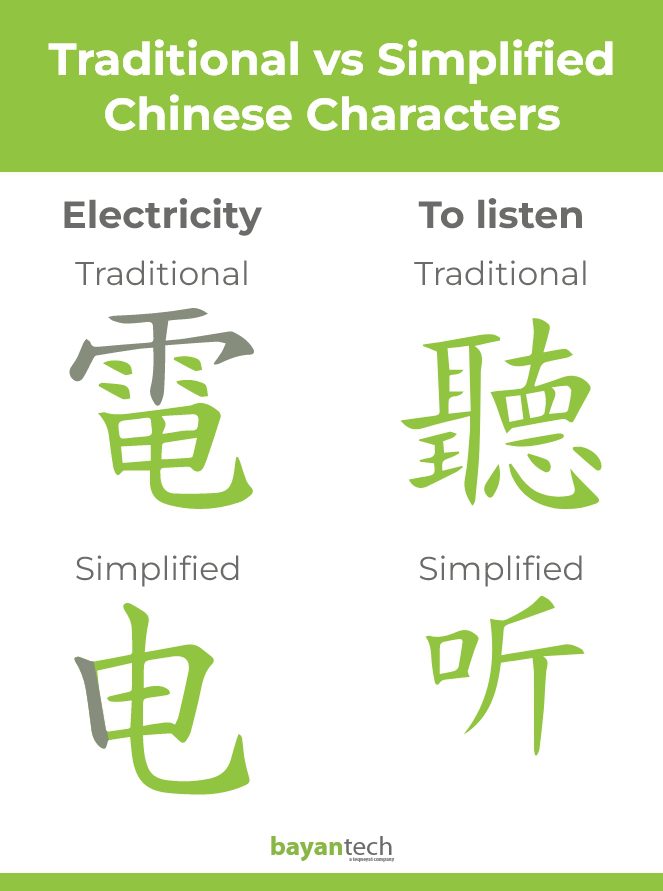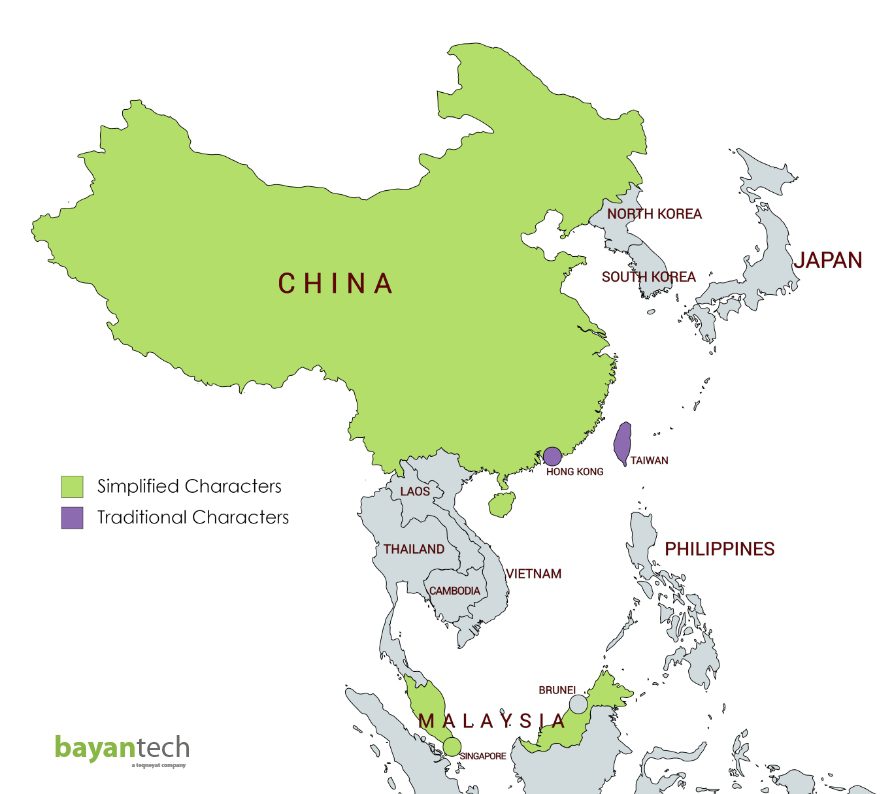Getting your product or service into the Chinese-speaking markets represents huge growth opportunities for your business. But it also requires translation and localization so you can build successful business relationships and connect with customers.
But here’s the challenging part: there are different types of spoken and written Chinese.
One of the most critical decisions you’ll face when localizing your content for Chinese-speaking audiences is choosing between the two main writing systems: traditional vs simplified Chinese.
Unsure which writing form you should translate your content into?
In this guide, you’ll learn all about the differences and similarities between these two variations and how to choose the right system for your localization projects.
Traditional vs Simplified Chinese: A Brief History of the Chinese Writing System
Contrary to popular belief, Chinese is not a single language. It refers to a group of different spoken languages and dialects. Chinese also has two different written forms: traditional Chinese and simplified Chinese, which is what we’re tackling today.
Let’s break down how these two written variations evolved.
The Origins of The Chinese Language
Chinese uses a logographic writing system. This means that instead of letters, Chinese uses a set of characters, each symbol representing a certain word or meaning on its own.
This system originated from the earliest form of Chinese writing, which was carved on oracle bones, dating back to around 1250 BCE. At the time, Chinese was pictographic, meaning the characters looked like the things they represented.
As time went on, these pictograms evolved and became more abstract and combined with other symbols to represent more complex ideas.
This era laid the groundwork for the traditional Chinese character structure we see today.
How Traditional Chinese Evolved into Simplified Chinese
After the foundation of the People’s Republic of China in the 1950s, the government introduced simplified Chinese to increase literacy rates. Essentially, simplified Chinese is just what it sounds like; it’s a new simplified writing system with less complex characters.
By simplifying the written language, more people could easily learn to write and memorize Chinese characters which improved China’s literacy rate over the years.
However, the traditional Chinese writing system wasn’t entirely replaced since it’s still used in some Chinese-speaking populations. And this is why, today, Chinese languages have two separate writing systems.
So, What Are the Differences & Similarities between Traditional & Simplified Chinese?
-
Character Complexity
One of the main differences between traditional and simplified Chinese is the complexity of the characters. Simplified Chinese characters are less complex and have fewer strokes and components.
Here’s an example:
The character for “to write” in traditional Chinese is (書) and has 10 strokes. Meanwhile, in simplified Chinese, the character for the same word became (书) with only 4 strokes.
-
Meaning
When it comes to the meaning of characters, there is generally no difference between traditional and simplified Chinese. Although characters have been simplified, the meaning remains the same in most cases.
However, there are a few rare instances where the simplification process resulted in simplified characters having broader or multiple meanings, whereas the traditional character has a more specific meaning.
-
Pronunciation
Despite the differences in the written form between traditional vs simplified Chinese, the pronunciation remains the same. In other words, a character in traditional Chinese and its simplified counterpart are pronounced the same way, regardless of the writing system.
The reason for this is that the simplification process only affected the written characters and did not change the spoken language and its various dialects.
Key takeaway: the writing system of choice does not dictate the dialect you use, such as Mandarin and Cantonese. This guide below will help you understand which dialect and writing system is used in each market.
Where Is Each Chinese Character Set Used?
When it comes to where traditional vs simplified Chinese is used, it all depends on the geographic location.
Simplified Chinese is spoken in:
- Mainland China
- Singapore
- Malaysia
Meanwhile, traditional Chinese is used in:
- Hong Kong
- Taiwan
- Macau
|
Did you know Chinese is one of the most difficult languages to learn in the world? If you’re curious to learn the reasons behind its complexity and interesting facts about Chinese, check out our blog post: |
How to Choose Between Traditional vs Simplified Chinese in Translation for Your Business?
Choosing between traditional and simplified Chinese translation for your business depends to a great extent on your target market and business goals. Where are your ideal audiences located?
If your main focus is mainland China, Singapore, or Malaysia, simplified Chinese is the right choice. But if you’re targeting Macau, Hong Kong, and Taiwan, you should translate into traditional Chinese.
Additionally, the nature of your content can sometimes be another factor to consider.
If you’re translating marketing materials, technical documents, websites, and business communications, simplified Chinese is the way to go. On the other hand, if you’re translating a historical document or a piece of literature, traditional Chinese might be more appropriate to maintain the original essence.
Traditional vs Simplified Chinese: Which One Is More Common?
According to the numbers, simplified Chinese is significantly more common with around 97% to 98% of Chinese speakers using simplified Chinese, while only 2% to 3% use traditional characters.
However, despite the dominance of simplified Chinese, deciding which writing system to use for translation should not be based solely on the number of users. You should consider other factors to make sure you don’t miss out on potential customers.
So, study your target audience beforehand. Consider factors such as their geographic location, age group, and local language. Additionally, think about your business goals and the potential return on investment (ROI) of the language you’re investing in.
Enter the Chinese Market Confidently with bayantech Chinese Localization Solutions
bayantech is a leading language services provider with twenty years of experience serving regional and global businesses across various industries. We translate your business documents and communications from English to Chinese and from Arabic to Chinese, covering +120 languages.
Whether you want to translate your documents using simplified or traditional characters, our Chinese translation services will help you localize your content in your target audience’s local language and make sure it resonates with customers on a deeper level.
Contact us today and start connecting with your Chinese-speaking customers and partners effectively.










